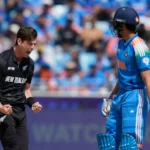Now Reading: Ind vs NZ Final: Key Facts for the ICC Champions Trophy Showdown
-
01
Ind vs NZ Final: Key Facts for the ICC Champions Trophy Showdown

Ind vs NZ Final: Key Facts for the ICC Champions Trophy Showdown
Firstly, New Zealand boasts a strong spin bowling attack that has become a cornerstone of their bowling strategy. Led by left-arm spinner Mitchell Santner, the spin unit also features Michael Bracewell, Glenn Phillips, and Rachin Ravindra each bringing unique skills to the fore. Santner’s ability to extract sharp turn and maintain tight lines often forces batsmen into making errors, while Bracewell’s subtle variations in pace and flight add another dimension to the attack. Phillips and Ravindra complement this unit by introducing different spin techniques, ensuring that the Kiwis can adapt their approach to exploit any weakness in the batting lineup. Additionally, the pitch conditions in New Zealand tend to offer extra assistance to spinners as the game wears on, with increased turn and variable bounce. This means that as the match progresses, the spinners can intensify the pressure, and India must adapt quickly by revising their shot selection and defensive tactics to counter the added turn and subtle variations.
Next, New Zealand’s fast bowlers provide a formidable challenge right from the start with the new ball. Their tall pacers consistently bowl a good length and can generate extra bounce, often catching batsmen off guard with late movement off the pitch. This early-ball threat is particularly effective in unsettling the top order, where even small lapses in technique can lead to quick wickets. The combination of height, pace, and precision means that the early overs become a critical period, forcing the batsmen to be extra cautious. For India, this underlines the need to have a well-thought-out strategy during the Powerplay. The top order must look to build a stable platform while being mindful of the extra movement and bounce on offer. A balanced approach of aggression mixed with sensible shot selection will be key to navigating these early challenges, ensuring that the team can build momentum without compromising their wicket-taking opportunities.
By understanding and preparing for these dual threats—the crafty spin and the incisive pace India can better formulate strategies that address both dimensions of New Zealand’s bowling attack.
Additionally, New Zealand excels in fielding. The team saves many runs with sharp catches and speedy moves. Glenn Phillips and his teammates often turn half-chances into crucial wickets. As a result, every catch and run saved adds extra pressure on India.
Moreover, New Zealand has a solid batting line-up. With players such as Rachin Ravindra, Will Young, and Kane Williamson, they can score quickly and build a steady innings. Their batsmen handle spin well, which makes them even more competitive in the ind vs nz final.
The match will take place on a pitch that displays varied characteristics. New Zealand’s bowlers may use these conditions to their advantage, while India must score carefully in every phase of the game.
In summary, the ind vs nz final will test the skills and strategies of both teams. India needs to counter the Kiwis’ spin attack, seam movement, and excellent fielding to secure a win in this high-stakes match.
Overall, fans should expect a battle of tactics and talent on the day. Stay tuned for further updates as match day approaches, and watch as every over presents a new challenge in this exciting final.









Pingback: Ben Stokes Considered for England ODI Captaincy, Harry Brook for T20